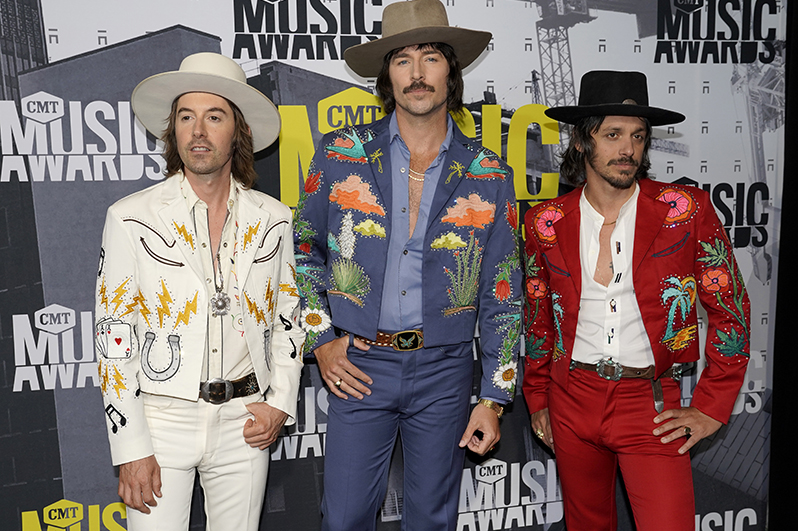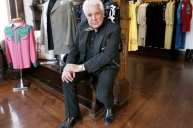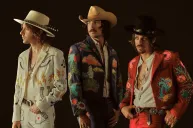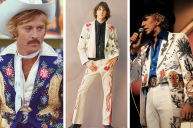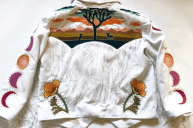In country music, glitz and glamour is back in a big way. Rhinestones, fringe, sharp suits and all things western wear are enjoying a revival courtesy of a new generation of artists. Look no further than the cover of Mr. Jukebox, the debut album from Joshua Hedley. Hedley peers off the cover wearing an Everglades themed rhinestone suit, an homage to his Florida roots. Porter had wagon wheels; Hedley has blue herons and a gator.
Videos by Wide Open Country
Margo Price, Kelsey Waldon, Midland, Nikki Lane, Robert Ellis and more have donned stage wear that pays tribute to country's past while reflecting their own style and personalities. Of course, none of that would be possible without those behind the sewing and chainstitch machines.
Throughout the years, Nathan Turk, Rodeo Ben, Nudie Cohn and Manuel, who's dressed everyone from Elvis to Dwight Yoakam and continues to be the most in-demand designer for country artists, have helped artists to express themselves on stage. Now a new group of designers are helping to lead the way in country's western wear revival.
The Rhinestone Revolution
Lady Gaga may not be the first name you think of when you think of western wear, but when she wanted to dress the part for the Nashville leg of her Bud Light Dive Bar Tour, she wore vintage Manuel and turned to Nashville designer and Manuel protege Riley Reed.
Reed, who's designed clothes for Lady Gaga, Margo Price, Kelsey Waldon and more, got her start interning for the Rhinestone Rembrandt himself.
"I was very interested in vintage fashion, like '40s and '50s type of stuff. So when I was supposed to do my internship after getting my degree -- what went along with my interest the most here in Nashville was Manuel (and that's) western wear," Reed says. "That was a great time. I learned a lot. Being like 23 years old and having a bunch of famous people coming in to where you work [laughs] and getting to work on those things, I couldn't have asked for anything better than that."
Reed is also an integral part of the Nashville Boogie Western Roundup Fashion Show, a celebration of mid-century country and western fashion.
Reed says western wear has always been about more than having something sparkly to where on stage. Western stage wear provided a sense of pride to those who had often came from little.
"It comes from show costumes--from cowboys who needed showy costumes. I think once they started getting onstage they needed things that kind of stood out," Reed says. "Every garment was made specifically for the person so it was almost like advertising for them too. I really think that's why--just for the showmanship and personalization of it, too. Having something specifically custom made for them, it's kind of like having a Cadillac or something. It's a status symbol."
Hillbilly Bands and Cowboys
When it came to loud and proud clothing, no one did it better than the Maddox Brothers and Rose. The family of four brothers and one sister traveled the country from the '30s through the early '50s sharing their brand of "country boogie." Today, the Maddox Brothers and Rose are known as pioneers of rockabilly music, but they may be equally as known for their extravagant clothing.
Known as America's Most Colorful Hillbilly Band, the Maddox Brothers and Rose were early adopters of western wear and their go-to designer was Van Nuys, Calif.-based tailor Nathan Turk.
Turk, who included Roy Rogers, Gene Autry and Patsy Cline among his clients, perfected the gabardine western shirt.
According to Holly George-Warren and Michelle Freedman's book "How the West Was Worn: A History of Western Wear" movie studios frequently called on Turk to design clothing for their western films. Soon, musicians were following suit.
Janet Aspley, a designer and owner of the U.K.-based company Dandy and Rose, not only makes western wear, she's also a writer and PhD student researching the clothes of country and western stars.
While Aspley includes Turk's designs for the Maddox Brothers and Rose among her favorite pieces, it was a seemingly unlikely artist who first led her to country music history.
"It's something that people can easily identify," Aspley says. "Maybe their images weren't so well known as they are now so as soon as you say someone -- if you saw Webb Pierce and he was in his 'In The Jailhouse Now' suit, you'd know who he was."
Flashy suits also allowed stars to briefly shed their down-home identities without alienating themselves from their audience.
"They also had these kind of stage personas...They had these names that were like names of heroes of western TV series or movies," Aspley says. "When they're onstage they have this different performance persona."
Read More: Manuel Cuevas is 'The Rhinestone Rembrandt' Who Makes Country Stars Shine
The Hollywood Factor
Rhinestones, fringe and intricate embroidery was a far cry from the everyday workwear of early country stars. But the overwhelming influence of cowboy movies proved irresistible to singing stars--no matter their background.
"I think really it came from western movies -- from the singing cowboys. It was so much more glamorous than what they had been wearing before," Aspley says. "I think they also made a conscious attempt to try to distance themselves from the hillbilly image."
Like Turk, Nudie Cohn and Manuel had a hand in designing clothing and accessories for films and television.
"It's always been a bit of crossover from movies to music, but of course it's taken on its own meaning now in country music," says Aspley, adding that the style has become synonymous with traditional country music. "It's gradually become what a real country singer wears. That's what my research is about--it's about how embellished and embroidered, rhinestoned western wear has become associated with authenticity."
But for all the effort to spruce up their image, country stars have always been careful to stay grounded.
"I think for Nudie suits in their heyday, it's a really interesting little conundrum because they were really expensive and they look really over-the-top. They're a way of loudly saying, 'I'm really famous and successful' but at the same time, because the level of taste is quite kitsch, it's working class taste," Aspley says. "It's a way of saying 'I am actually still like you. I haven't gotten too big for my boots. I'm not too sophisticated to dress like this.'"
The New Class
With Aspley, Reed and the ever-influential Manuel, along with companies such as Fort Lonesome, Rusty Cuts and designer Jerry Lee Atwood of Union Western Clothing, modern western wear is in good hands. And it's not just for country stars and western movies anymore.
In the past two decades, western wear has turned up on MTV, the Grammy Awards, in fashion magazines and even on the runway. Most recently, Nashville natives Miley Cyrus and Kesha have donned vintage and vintage-inspired suits in the style of Nudie Cohn and Manuel.
Reed says it's a case of fashion being cyclical.
"I think that high fashion always looks first to what people are wearing. They're just seeing that style becoming bigger with these artists that do more traditional country," Reed says. "It's called trickle up, so it trickles up from there to the Lady Gagas and Keshas and everybody like that."
So what's it like to see your work worn by music's best and brightest? Reed, who's worked as a wardrobe assistant for Dolly Parton in addition to her work as a sought-after designer, says it puts the fashion industry into perspective.
"It's surreal that I made that --that was in my studio being created and now it's in print or somebody's wearing it on stage," Reed says. "I just really think about all the other things that people wear that you never think about where they come from or how long it took to make them."
Aspley recalls the first time she saw her clothing worn onstage at the Mother Church of country music.
"It's absolutely amazing. The first time that I saw one on the stage of the Ryman -- that was incredible," Aspley said. "It was what we in Britain call gobsmacking."
You can see Riley Reed's designs in person at the Nashville Boogie Western Fashion Show on May 26.
Janet Aspley's western shirts can be found at Dandy & Rose.
